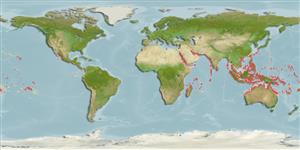Environment: milieu / climate zone / depth range / distribution range
Ecologie
marien rifbewoner; diepte 1 - 15 m (Ref. 90102). Tropical; 30°N - 24°S
Indo-West Pacific: Maldives (Ref. 30829) and Mauritius to Indonesia, Singapore, the Philippines, Papua New Guinea and the Solomon Islands. Recently reported from New Caledonia (Ref. 11889).
Grootte / Gewicht / Leeftijd
Maturity: Lm ? range ? - ? cm
Max length : 15.0 cm TL mannelijk / geslacht onbekend; (Ref. 48635)
Korte beschrijving
Determinatiesleutels | Morfologie | Morfometrie
Dorsale stekels (totaal) : 3; Dorsale zachte stralen (totaal) : 11 - 12; Anale stekels: 0; Anale zachte stralen: 6 - 7. Characterized by numerous prominent wart-like protuberances on its skin and a large esca that mimics a tiny fish. Bony part of the illicium with numerous crossbands and approximately twice as long as the 2nd dorsal spine. Coloration is highly variable, ranging from cream to yellow, brown, or black with scattered dark circular spots and saddles or blotches ranging from white to pink, rust-red, or red. Heavily spotted individuals resemble A. pictus. Usually has red or orange margins on all fins and the first band across the body diverts to the posterior edge of the eye which distinguishes it from A. pictus (Ref. 48635).
Inhabit sheltered rocky reefs (Ref. 559). Adults are usually with sponges (Ref. 48635). Juveniles openly on reefs looking like nudibranchs (Ref. 48635). Feeds on fishes (Ref. 89972). Oviparous. Eggs are bound in ribbon-like sheath or mass of gelatinous mucus called 'egg raft' or 'veil' (Ref. 6773). Solitary, frequently among algae, sponges and soft corals (Ref 90102).
Levenscyclus en paargedrag
Maturiteit | Voortplanting | Paaien | Eieren | Fecunditeit | Larven
Oviparous. Eggs are bound in ribbon-like sheath or mass of gelatinous mucus called 'egg raft' or 'veil' (Ref. 6773).
Pietsch, T.W. and D.B. Grobecker, 1987. Frogfishes of the world. Systematics, zoogeography, and behavioral ecology. Stanford University Press, Stanford, California. 420 p. (Ref. 6773)
Status op de Rode Lijst van het IUCN (Ref. 130435: Version 2024-2)
Gevaar voor de mens
Harmless
Gebruik door de mens
Visserij: van geen belang; Aquarium: Commercieel
Tools
Speciale rapporten
Download XML
Internetbronnen
Estimates based on models
Preferred temperature (Ref.
123201): 25.2 - 29.3, mean 28.5 °C (based on 3049 cells).
Fylogenetische diversiteitsindex (Ref.
82804): PD
50 = 0.5005 [Uniqueness, from 0.5 = low to 2.0 = high].
Bayesian length-weight: a=0.02630 (0.01029 - 0.06725), b=2.96 (2.73 - 3.19), in cm total length, based on LWR estimates for this (Sub)family-body shape (Ref.
93245).
Trofisch niveau (Ref.
69278): 4.2 ±0.73 se; based on food items.
Weerstandsvermogen (Ref.
120179): Hoog, minimale populatieverdubbelingstijd minder dan 15 maanden (Fec assumed to be > 10,000).
Fishing Vulnerability (Ref.
59153): Low vulnerability (10 of 100).
